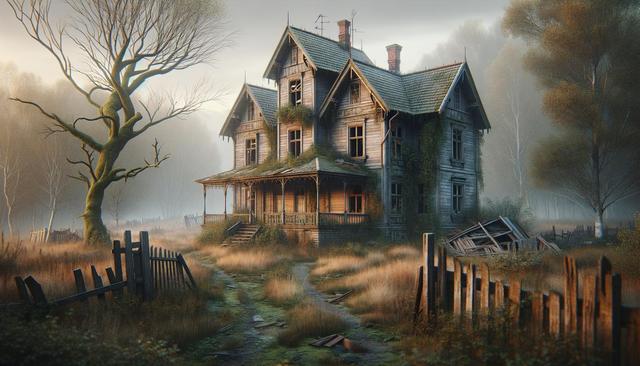The Silent Fate of Abandoned Houses
When a house is left vacant, it begins a slow process of decay that’s not only physical but also legal and economic. Abandoned properties often sit unnoticed in neighborhoods, attracting curiosity and sometimes concern. These houses may have been left behind due to financial hardship, inheritance issues, or legal disputes. Over time, nature reclaims the structure, and the home shifts from a once lively place to a shadow of its former self. Yet, these structures still hold significant value, especially for those looking for a house to buy or those working within house selling agencies. Despite their state, such properties can be the starting point for new investments or revitalization projects.
In many urban areas, abandoned houses are part of larger patterns of decline or transition. They can become hotspots for code violations, vandalism, and safety risks. However, they also represent opportunity. For example, city programs sometimes allow individuals to invest in houses for $500 in {city}, offering a low-cost entry point into property ownership. These efforts aim to reduce urban blight and encourage redevelopment through community engagement and private investment.
Legal and Financial Considerations
Before taking interest in an abandoned house, it’s crucial to understand the legal and financial implications. Ownership may be unclear, especially if the previous owner passed away without heirs or left unresolved debts. In such cases, the property might be tied up in probate or face tax foreclosure. Navigating these situations often requires legal assistance or guidance from house selling agencies experienced in distressed or abandoned properties.
Potential buyers should consider the following:
- Researching ownership history and tax records
- Checking for municipal liens or unpaid utility bills
- Evaluating the cost of repairs and renovations
- Understanding zoning laws and redevelopment restrictions
These considerations can significantly impact whether an abandoned house is worth pursuing. However, for someone willing to conduct due diligence, these properties can offer a unique chance to secure house property at a fraction of typical market prices.
Restoration and Adaptive Reuse
Transforming an abandoned house into a livable or functional space involves more than just cosmetic upgrades. Structural assessments are often necessary to determine the safety and viability of the building. In some cases, extensive repairs are required, including roof replacements, foundation work, and updated electrical systems. Despite these challenges, many individuals and organizations see potential in restoring such properties, especially when supported by local grants or tax incentives.
Adaptive reuse is another rising trend. Some buyers choose to convert abandoned houses into:
- Community centers or non-profit spaces
- Unique short-term rentals
- Art studios or co-working hubs
- Affordable housing units
These creative transformations not only preserve the architectural character of a neighborhood but also inject new life into forgotten spaces. House selling agencies often highlight such projects as examples of successful reinvestment in local communities.
Market Trends and Investment Potential
The market for abandoned houses varies widely depending on location, economic conditions, and regional policies. In some cities, the demand for affordable housing has driven renewed interest in these types of properties. Programs that allow residents to invest in houses for $500 in {city} are part of broader urban renewal strategies. These initiatives aim to attract buyers who are willing to take on renovation risks in exchange for lower upfront costs.
Real estate investors and developers are increasingly recognizing the potential of these neglected homes. With proper planning and budgeting, abandoned houses can yield favorable returns. Whether individuals are searching for a house to buy for personal use or considering long-term rental income, these properties offer a starting point.
Some signs that an abandoned house could be a strong investment include:
- Proximity to growing urban centers
- Availability of public transportation
- Local government incentive programs
- Historic or architectural appeal
Understanding these trends helps potential buyers make informed decisions when entering the market for house property that has been left behind.
Community Impact and Revitalization
Beyond individual gain, reclaiming abandoned houses has a ripple effect on neighborhoods. When one property is restored, it often encourages surrounding homeowners to invest in improvements as well. This snowball effect can uplift entire communities, reducing crime, increasing property values, and fostering local pride. Municipalities have recognized this and often partner with house selling agencies to promote targeted redevelopment strategies.
Community-based efforts may include:
- Neighborhood clean-up days focused on abandoned lots
- Local workshops on how to legally acquire and renovate vacant homes
- Public-private partnerships for affordable housing projects
- Volunteer-driven beautification programs
These initiatives not only support the housing market but also strengthen social bonds. A once-forgotten house can become a symbol of resilience and regeneration. For individuals exploring the house to buy market, such projects offer a meaningful way to invest in more than just property—they invest in people and places.
Conclusion: Hidden Potential in Forgotten Homes
Abandoned houses may appear lifeless, but they possess untapped possibilities for those willing to look beyond the surface. Whether you’re a first-time buyer, a seasoned investor, or someone passionate about community development, these properties can serve as catalysts for change. With the support of house selling agencies and city programs like those that allow you to invest in houses for $500 in {city}, reclaiming these homes becomes a realistic and rewarding venture. From overlooked structures to revitalized landmarks, abandoned houses tell stories of transformation—and offer opportunities for those ready to write the next chapter.




Leave a Reply